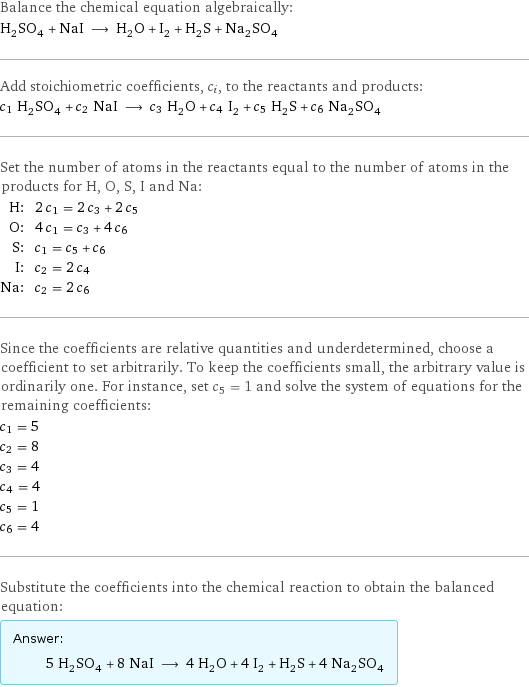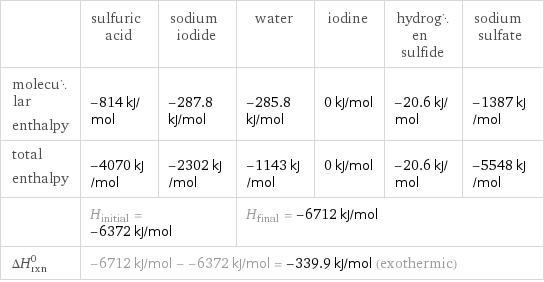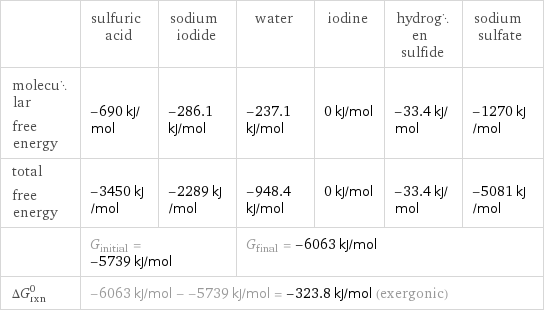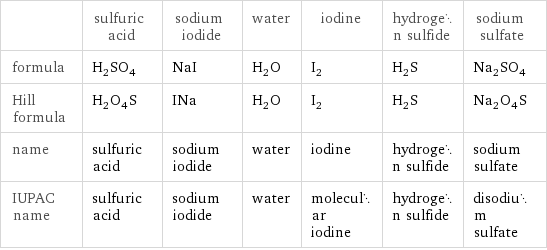Input interpretation

H_2SO_4 (sulfuric acid) + NaI (sodium iodide) ⟶ H_2O (water) + I_2 (iodine) + H_2S (hydrogen sulfide) + Na_2SO_4 (sodium sulfate)
Balanced equation

Balance the chemical equation algebraically: H_2SO_4 + NaI ⟶ H_2O + I_2 + H_2S + Na_2SO_4 Add stoichiometric coefficients, c_i, to the reactants and products: c_1 H_2SO_4 + c_2 NaI ⟶ c_3 H_2O + c_4 I_2 + c_5 H_2S + c_6 Na_2SO_4 Set the number of atoms in the reactants equal to the number of atoms in the products for H, O, S, I and Na: H: | 2 c_1 = 2 c_3 + 2 c_5 O: | 4 c_1 = c_3 + 4 c_6 S: | c_1 = c_5 + c_6 I: | c_2 = 2 c_4 Na: | c_2 = 2 c_6 Since the coefficients are relative quantities and underdetermined, choose a coefficient to set arbitrarily. To keep the coefficients small, the arbitrary value is ordinarily one. For instance, set c_5 = 1 and solve the system of equations for the remaining coefficients: c_1 = 5 c_2 = 8 c_3 = 4 c_4 = 4 c_5 = 1 c_6 = 4 Substitute the coefficients into the chemical reaction to obtain the balanced equation: Answer: | | 5 H_2SO_4 + 8 NaI ⟶ 4 H_2O + 4 I_2 + H_2S + 4 Na_2SO_4
Structures

+ ⟶ + + +
Names

sulfuric acid + sodium iodide ⟶ water + iodine + hydrogen sulfide + sodium sulfate
Reaction thermodynamics
Enthalpy

| sulfuric acid | sodium iodide | water | iodine | hydrogen sulfide | sodium sulfate molecular enthalpy | -814 kJ/mol | -287.8 kJ/mol | -285.8 kJ/mol | 0 kJ/mol | -20.6 kJ/mol | -1387 kJ/mol total enthalpy | -4070 kJ/mol | -2302 kJ/mol | -1143 kJ/mol | 0 kJ/mol | -20.6 kJ/mol | -5548 kJ/mol | H_initial = -6372 kJ/mol | | H_final = -6712 kJ/mol | | | ΔH_rxn^0 | -6712 kJ/mol - -6372 kJ/mol = -339.9 kJ/mol (exothermic) | | | | |
Gibbs free energy

| sulfuric acid | sodium iodide | water | iodine | hydrogen sulfide | sodium sulfate molecular free energy | -690 kJ/mol | -286.1 kJ/mol | -237.1 kJ/mol | 0 kJ/mol | -33.4 kJ/mol | -1270 kJ/mol total free energy | -3450 kJ/mol | -2289 kJ/mol | -948.4 kJ/mol | 0 kJ/mol | -33.4 kJ/mol | -5081 kJ/mol | G_initial = -5739 kJ/mol | | G_final = -6063 kJ/mol | | | ΔG_rxn^0 | -6063 kJ/mol - -5739 kJ/mol = -323.8 kJ/mol (exergonic) | | | | |
Equilibrium constant
![Construct the equilibrium constant, K, expression for: H_2SO_4 + NaI ⟶ H_2O + I_2 + H_2S + Na_2SO_4 Plan: • Balance the chemical equation. • Determine the stoichiometric numbers. • Assemble the activity expression for each chemical species. • Use the activity expressions to build the equilibrium constant expression. Write the balanced chemical equation: 5 H_2SO_4 + 8 NaI ⟶ 4 H_2O + 4 I_2 + H_2S + 4 Na_2SO_4 Assign stoichiometric numbers, ν_i, using the stoichiometric coefficients, c_i, from the balanced chemical equation in the following manner: ν_i = -c_i for reactants and ν_i = c_i for products: chemical species | c_i | ν_i H_2SO_4 | 5 | -5 NaI | 8 | -8 H_2O | 4 | 4 I_2 | 4 | 4 H_2S | 1 | 1 Na_2SO_4 | 4 | 4 Assemble the activity expressions accounting for the state of matter and ν_i: chemical species | c_i | ν_i | activity expression H_2SO_4 | 5 | -5 | ([H2SO4])^(-5) NaI | 8 | -8 | ([NaI])^(-8) H_2O | 4 | 4 | ([H2O])^4 I_2 | 4 | 4 | ([I2])^4 H_2S | 1 | 1 | [H2S] Na_2SO_4 | 4 | 4 | ([Na2SO4])^4 The equilibrium constant symbol in the concentration basis is: K_c Mulitply the activity expressions to arrive at the K_c expression: Answer: | | K_c = ([H2SO4])^(-5) ([NaI])^(-8) ([H2O])^4 ([I2])^4 [H2S] ([Na2SO4])^4 = (([H2O])^4 ([I2])^4 [H2S] ([Na2SO4])^4)/(([H2SO4])^5 ([NaI])^8)](../image_source/800ab8ae447a56c599f3db2c691cbfd3.png)
Construct the equilibrium constant, K, expression for: H_2SO_4 + NaI ⟶ H_2O + I_2 + H_2S + Na_2SO_4 Plan: • Balance the chemical equation. • Determine the stoichiometric numbers. • Assemble the activity expression for each chemical species. • Use the activity expressions to build the equilibrium constant expression. Write the balanced chemical equation: 5 H_2SO_4 + 8 NaI ⟶ 4 H_2O + 4 I_2 + H_2S + 4 Na_2SO_4 Assign stoichiometric numbers, ν_i, using the stoichiometric coefficients, c_i, from the balanced chemical equation in the following manner: ν_i = -c_i for reactants and ν_i = c_i for products: chemical species | c_i | ν_i H_2SO_4 | 5 | -5 NaI | 8 | -8 H_2O | 4 | 4 I_2 | 4 | 4 H_2S | 1 | 1 Na_2SO_4 | 4 | 4 Assemble the activity expressions accounting for the state of matter and ν_i: chemical species | c_i | ν_i | activity expression H_2SO_4 | 5 | -5 | ([H2SO4])^(-5) NaI | 8 | -8 | ([NaI])^(-8) H_2O | 4 | 4 | ([H2O])^4 I_2 | 4 | 4 | ([I2])^4 H_2S | 1 | 1 | [H2S] Na_2SO_4 | 4 | 4 | ([Na2SO4])^4 The equilibrium constant symbol in the concentration basis is: K_c Mulitply the activity expressions to arrive at the K_c expression: Answer: | | K_c = ([H2SO4])^(-5) ([NaI])^(-8) ([H2O])^4 ([I2])^4 [H2S] ([Na2SO4])^4 = (([H2O])^4 ([I2])^4 [H2S] ([Na2SO4])^4)/(([H2SO4])^5 ([NaI])^8)
Rate of reaction
![Construct the rate of reaction expression for: H_2SO_4 + NaI ⟶ H_2O + I_2 + H_2S + Na_2SO_4 Plan: • Balance the chemical equation. • Determine the stoichiometric numbers. • Assemble the rate term for each chemical species. • Write the rate of reaction expression. Write the balanced chemical equation: 5 H_2SO_4 + 8 NaI ⟶ 4 H_2O + 4 I_2 + H_2S + 4 Na_2SO_4 Assign stoichiometric numbers, ν_i, using the stoichiometric coefficients, c_i, from the balanced chemical equation in the following manner: ν_i = -c_i for reactants and ν_i = c_i for products: chemical species | c_i | ν_i H_2SO_4 | 5 | -5 NaI | 8 | -8 H_2O | 4 | 4 I_2 | 4 | 4 H_2S | 1 | 1 Na_2SO_4 | 4 | 4 The rate term for each chemical species, B_i, is 1/ν_i(Δ[B_i])/(Δt) where [B_i] is the amount concentration and t is time: chemical species | c_i | ν_i | rate term H_2SO_4 | 5 | -5 | -1/5 (Δ[H2SO4])/(Δt) NaI | 8 | -8 | -1/8 (Δ[NaI])/(Δt) H_2O | 4 | 4 | 1/4 (Δ[H2O])/(Δt) I_2 | 4 | 4 | 1/4 (Δ[I2])/(Δt) H_2S | 1 | 1 | (Δ[H2S])/(Δt) Na_2SO_4 | 4 | 4 | 1/4 (Δ[Na2SO4])/(Δt) (for infinitesimal rate of change, replace Δ with d) Set the rate terms equal to each other to arrive at the rate expression: Answer: | | rate = -1/5 (Δ[H2SO4])/(Δt) = -1/8 (Δ[NaI])/(Δt) = 1/4 (Δ[H2O])/(Δt) = 1/4 (Δ[I2])/(Δt) = (Δ[H2S])/(Δt) = 1/4 (Δ[Na2SO4])/(Δt) (assuming constant volume and no accumulation of intermediates or side products)](../image_source/1522f27f5df0edfc88ad713769c65d5d.png)
Construct the rate of reaction expression for: H_2SO_4 + NaI ⟶ H_2O + I_2 + H_2S + Na_2SO_4 Plan: • Balance the chemical equation. • Determine the stoichiometric numbers. • Assemble the rate term for each chemical species. • Write the rate of reaction expression. Write the balanced chemical equation: 5 H_2SO_4 + 8 NaI ⟶ 4 H_2O + 4 I_2 + H_2S + 4 Na_2SO_4 Assign stoichiometric numbers, ν_i, using the stoichiometric coefficients, c_i, from the balanced chemical equation in the following manner: ν_i = -c_i for reactants and ν_i = c_i for products: chemical species | c_i | ν_i H_2SO_4 | 5 | -5 NaI | 8 | -8 H_2O | 4 | 4 I_2 | 4 | 4 H_2S | 1 | 1 Na_2SO_4 | 4 | 4 The rate term for each chemical species, B_i, is 1/ν_i(Δ[B_i])/(Δt) where [B_i] is the amount concentration and t is time: chemical species | c_i | ν_i | rate term H_2SO_4 | 5 | -5 | -1/5 (Δ[H2SO4])/(Δt) NaI | 8 | -8 | -1/8 (Δ[NaI])/(Δt) H_2O | 4 | 4 | 1/4 (Δ[H2O])/(Δt) I_2 | 4 | 4 | 1/4 (Δ[I2])/(Δt) H_2S | 1 | 1 | (Δ[H2S])/(Δt) Na_2SO_4 | 4 | 4 | 1/4 (Δ[Na2SO4])/(Δt) (for infinitesimal rate of change, replace Δ with d) Set the rate terms equal to each other to arrive at the rate expression: Answer: | | rate = -1/5 (Δ[H2SO4])/(Δt) = -1/8 (Δ[NaI])/(Δt) = 1/4 (Δ[H2O])/(Δt) = 1/4 (Δ[I2])/(Δt) = (Δ[H2S])/(Δt) = 1/4 (Δ[Na2SO4])/(Δt) (assuming constant volume and no accumulation of intermediates or side products)
Chemical names and formulas

| sulfuric acid | sodium iodide | water | iodine | hydrogen sulfide | sodium sulfate formula | H_2SO_4 | NaI | H_2O | I_2 | H_2S | Na_2SO_4 Hill formula | H_2O_4S | INa | H_2O | I_2 | H_2S | Na_2O_4S name | sulfuric acid | sodium iodide | water | iodine | hydrogen sulfide | sodium sulfate IUPAC name | sulfuric acid | sodium iodide | water | molecular iodine | hydrogen sulfide | disodium sulfate